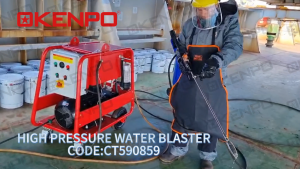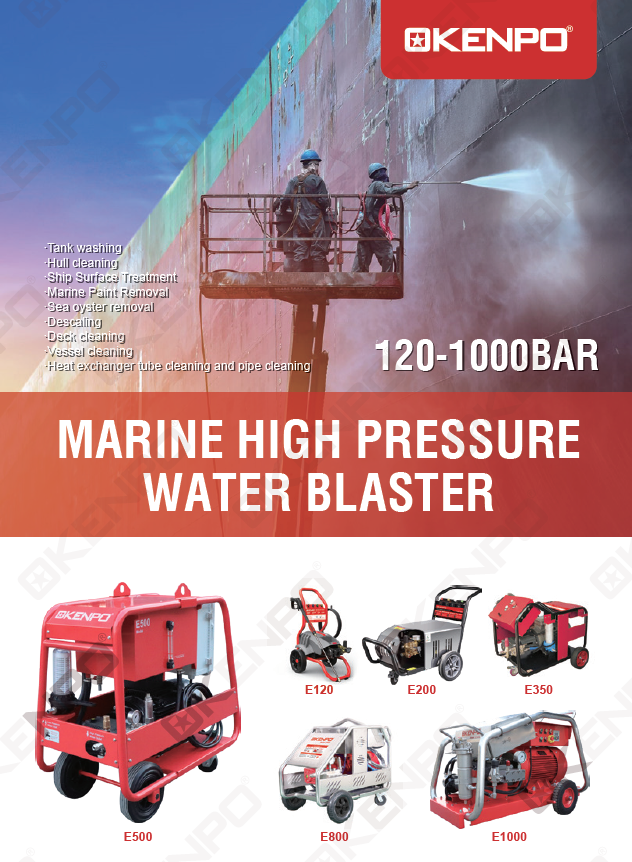High-pressure water blasters, such as the KENPO-E500, serve as essential instruments for efficient cleaning in a variety of sectors, including marine, industrial, and commercial fields. Nevertheless, their effectiveness and safety are significantly dependent on appropriate preparation prior to use. This article delineates the critical steps and precautions necessary to guarantee that operators can utilize the KENPO-E500 both safely and effectively.
Preparing for Use
Before commencing any cleaning tasks, it is vital to adequately prepare the KENPO-E500. The following recommendations provide a structured method for preparing the equipment:
1. Ensure Proper Ventilation
The KENPO-E500′s motor necessitates sufficient ventilation for optimal operation. Prior to activating the machine, confirm that there are no barriers obstructing the ventilation ports. Adequate air circulation is essential to prevent overheating, which could result in equipment malfunction or damage.
2. Maintain a Stable Operating Position
It is crucial to ensure that the KENPO-E500 is positioned on a flat, stable surface during operation. The machine should not be tilted at an angle exceeding 10 degrees. An unstable setup can lead to accidents, posing risks to the operator and potentially harming the equipment. Always assess the ground conditions before use to ensure stability.
3. Monitor Hose Positioning
When extending the high-pressure hose to considerable heights, be mindful that gravity can influence the water pressure. A hose raised too high may suffer from a reduction in pressure, resulting in ineffective cleaning. Strategically plan the hose’s positioning to guarantee optimal performance and maintain consistent pressure throughout the cleaning process.
4. Utilize Suitable Water Sources
The KENPO-E500 is intended to function exclusively with clean or non-aggressive water. The use of seawater or other inappropriate water sources may result in damage to the pump and adversely impact the machine’s lifespan. Always ensure that the machine is filled with the correct type of water to guarantee smooth operation and avoid expensive repairs.
5. Perform Comprehensive Equipment Inspections
Prior to operating the KENPO-E500, it is essential to carry out a thorough inspection of all equipment. This should involve checking the condition of hoses, connections, nozzles, and lances. Be vigilant for any indications of wear, leaks, or damage. Operating with compromised equipment can result in accidents and subpar cleaning outcomes. Confirm that all components are in safe working order before beginning any tasks.
6. Utilize Personal Protective Equipment (PPE)
Safety must always be prioritized. Operators are required to don appropriate personal protective equipment, which includes eye protection, gloves, and non-slip footwear. This equipment is crucial in preventing injuries from high-pressure jets and any debris that may be dislodged during the cleaning process.
Training and Operator Preparedness
Operator Training
Before operating the KENPO-E500, it is imperative that operators receive adequate training on its use. This training should encompass:
1. Preparation for Use: Gaining an understanding of the necessary steps to prepare the machine prior to operation.
2. Correct Handling of the Overflow Gun: Operators should be instructed on the proper way to hold the overflow gun to effectively manage the recoil force produced by the high-pressure jet. A proper grip minimizes the risk of accidents and improves control during operation.
3. Operation Procedures: Familiarity with the machine’s controls and functions is vital. Operators should be well-versed in how to safely and effectively adjust settings.
Significance of the User Manual
The user manual serves as a vital tool for comprehending the operation of the machine. It is imperative for operators to thoroughly review the manual prior to usage in order to become acquainted with the features, maintenance needs, and safety measures of the KENPO-E500. Neglecting this step may result in improper use and potential risks.
Understanding Safety Mechanisms
Unloader and Safety Valve Protection
The KENPO-E500 comes with factory-configured unloader and safety valves. The unloader valve manages the machine’s pressure based on the nozzle size, while the safety valve safeguards against overpressure conditions. It is essential to refrain from altering these settings without adequate training. Improper modifications can cause considerable damage to the machine, void the warranty, and create safety risks.
Should adjustments be required, they must only be executed by qualified personnel who are aware of the consequences of such modifications. This guarantees that the machine functions within its intended parameters, thereby preserving safety and efficiency.
Electrical Components
Considering the operational environment on vessels, the KENPO-E500 is designed with an IP67 waterproof electric box. This construction shields the electrical components from moisture and dust, thereby enhancing the machine’s longevity. Furthermore, the electric box is equipped with an emergency stop button switch. This switch is crucial for swiftly deactivating the machine in emergency scenarios, ensuring the safety of the operator.
Basic Maintenance and Troubleshooting
Consistent maintenance is essential for the KENPO-E500 to guarantee its durability and peak performance. Operators should follow these maintenance protocols:
1. Daily Inspections: Conduct daily examinations of hoses, nozzles, and connections for signs of wear. Any damaged components should be replaced immediately to avert accidents during operation.
2. Cleaning and Storage: Following each use, it is essential to clean the machine in accordance with the manufacturer’s guidelines. Adequate cleaning is crucial for maintaining performance and preventing corrosion. The machine should be stored in a dry, protected location to shield it from environmental harm.
3. Regular Servicing: It is advisable to arrange for periodic professional servicing of the KENPO-E500. A certified technician can conduct thorough inspections and maintenance activities, ensuring that the machine remains in optimal condition.
Troubleshooting Common Issues
Operators should be equipped to address common problems that may occur during operation. Understanding the machine’s fundamental functions can assist in early problem identification, facilitating prompt resolutions.
1. Pressure Drops: In the event of an unexpected drop in water pressure, inspect the hose for kinks or the nozzle for blockages.
2. Strange Noises: Any unusual sounds during operation may suggest mechanical issues. Immediately turn off the machine and check for any visible problems.
3. Leaks: Visible leaks must be addressed without delay. Examine hoses and connections to locate the source of the leak and replace any damaged components as needed.
Conclusion
The KENPO-E500 high-pressure water blaster is a robust tool for effective cleaning when utilized correctly and safely. By adhering to the preparation guidelines, ensuring proper operator training, and following safety protocols, users can optimize performance while reducing risks. Regular maintenance and troubleshooting expertise further improve the machine’s durability and efficiency. Emphasizing safety and preparation not only safeguards the operator but also guarantees that the KENPO-E500 achieves exceptional cleaning results across various applications.
Post time: Aug-06-2025








